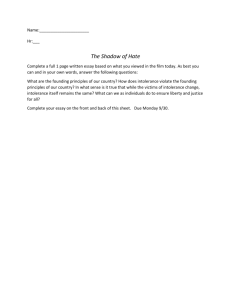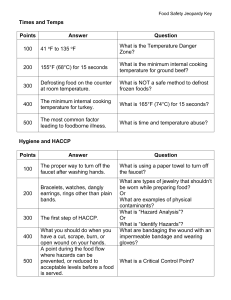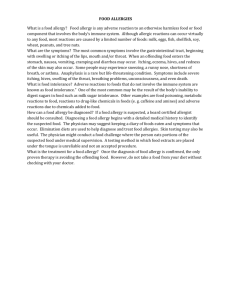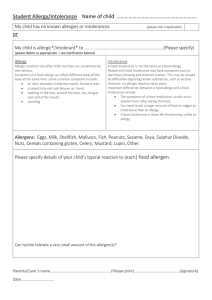Food intolerance and coeliac disease What this guide contains
advertisement
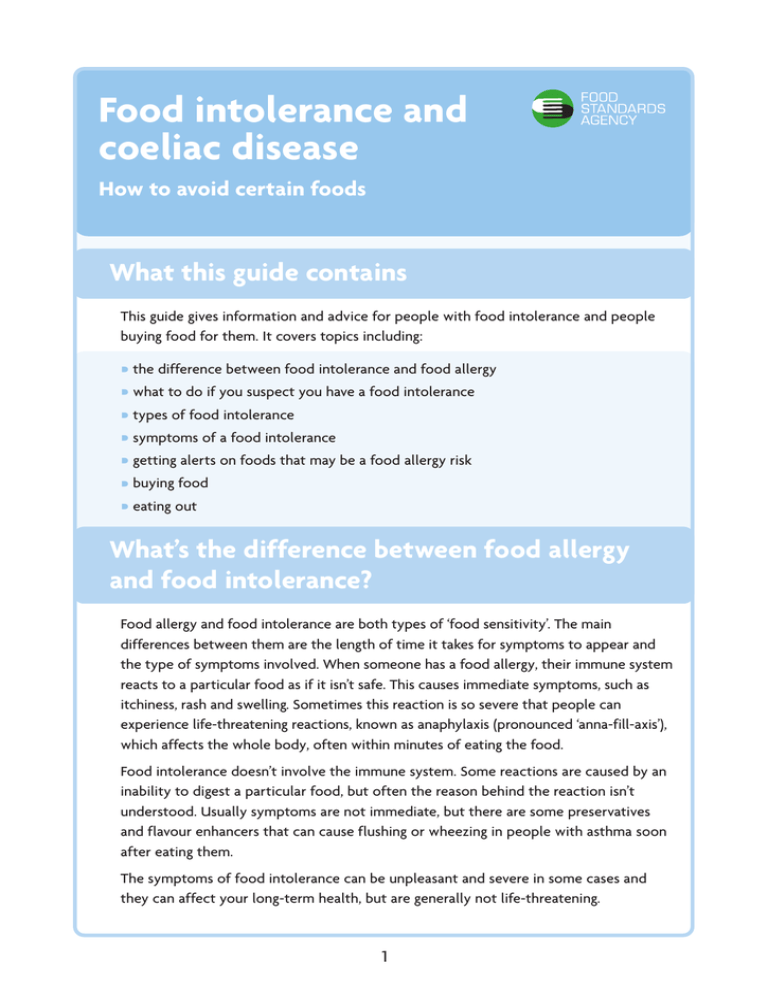
Food intolerance and coeliac disease How to avoid certain foods What this guide contains This guide gives information and advice for people with food intolerance and people buying food for them. It covers topics including: • the difference between food intolerance and food allergy • what to do if you suspect you have a food intolerance • types of food intolerance • symptoms of a food intolerance • getting alerts on foods that may be a food allergy risk • buying food • eating out What’s the difference between food allergy and food intolerance? Food allergy and food intolerance are both types of ‘food sensitivity’. The main differences between them are the length of time it takes for symptoms to appear and the type of symptoms involved. When someone has a food allergy, their immune system reacts to a particular food as if it isn’t safe. This causes immediate symptoms, such as itchiness, rash and swelling. Sometimes this reaction is so severe that people can experience life-threatening reactions, known as anaphylaxis (pronounced ‘anna-fill-axis’), which affects the whole body, often within minutes of eating the food. Food intolerance doesn’t involve the immune system. Some reactions are caused by an inability to digest a particular food, but often the reason behind the reaction isn’t understood. Usually symptoms are not immediate, but there are some preservatives and flavour enhancers that can cause flushing or wheezing in people with asthma soon after eating them. The symptoms of food intolerance can be unpleasant and severe in some cases and they can affect your long-term health, but are generally not life-threatening. 1 People with a food allergy need to avoid all forms and traces of that food, however small the amount. But people with food intolerances can usually consume small amounts of the food, although the amounts they can eat without symptoms will vary from person to person. There is also a Food Standards Agency factsheet on food allergy. See eatwell.gov.uk/allergy Types of food intolerance There are many foods that people can be intolerant to, but the most common food intolerances are to milk and lactose (the sugar in milk), gluten, wheat, food preservatives, and naturally occurring compounds in foods such as caffeine. Many people think that milk affects them, and for some, this will be due to lactose intolerance. This is caused by a shortage of the enzyme lactase, which is needed to break down lactose so it can be absorbed into the bloodstream. When someone doesn’t have enough of this enzyme, lactose isn’t absorbed properly from the gut. In the UK and Ireland, about 5 in 100 of the adult population are lactose intolerant. Some people with lactose intolerance find that they can cope with small amounts of milk in their diet, such as a milk glaze on pastry, or one or two pieces of chocolate, but the amount that someone can tolerate varies from person to person. Milk intolerance is common in children under the age of two years. It is similar to an allergy and if not treated can result in malnutrition. Many people experience symptoms after eating wheat, which could be caused by wheat intolerance. But this could also be a sign of gluten intolerance, also known as coeliac disease, so it’s important to talk to a health professional for a proper diagnosis. Many people think they are affected by food additives, but this type of intolerance affects only a small number of children and adults. The additives most commonly linked to food intolerance are artificial colours such as tartrazine; sulphites, metabisulphites and benzoates (types of preservative); and monosodium glutamate (a flavour enhancer). Some foods contain compounds that may affect sensitive individuals. Red wine, cheese and chocolate are well known for triggering headaches and migraines in some people. Red wine can also cause flushing. Common symptoms of a food intolerance are: • diarrhoea • weight loss • bloating • anaemia 2 Some food intolerances can cause symptoms normally associated with a food allergy such as flushing, headache, hives, wheezing and a runny nose. Generally, you won’t experience all of the symptoms at the same time and you should bear in mind that some of the symptoms of a food intolerance can also be symptoms of other illnesses. Many people who have been told they have a problem with their digestion, such as Irritable Bowel Syndrome (IBS), may think that foods such as milk or wheat make their problem worse. These foods have also been linked to other conditions. It is really important to get some professional medical advice before cutting out foods such as milk and wheat. Not everyone with IBS or other gastrointestinal problems will find it helpful to cut these foods out of their diet. This could make your condition worse, and could lead to you missing out on important vitamins and minerals. Gluten intolerance (coeliac disease) Coeliac disease is not an allergy. It is an ‘autoimmune disease’, which means that the body produces antibodies that attack its own tissues. For people with coeliac disease, this attack is triggered by gluten, a protein found in cereals such as wheat, rye and barley. In addition to the general symptoms of a food intolerance, some more specific symptoms of coeliac disease include: • nausea • wind • tiredness • constipation • reduced growth • skin problems Cereals containing gluten are used in lots of foods including various types of bread, pasta, pizza, pastry and cakes. Wheat ingredients are used in many other foods, such as some sausages and burgers, and many sauces. Foods in batter or breadcrumbs aren’t suitable for people with coeliac disease either. Always check the ingredients on the foods you buy. If you have coeliac disease you will also need to avoid some alcoholic drinks made from barley, such as beer and lager. Oats contain a protein that is similar to gluten, but not exactly the same. Research has shown that some people with coeliac disease can’t tolerate oats or oat products. It’s also possible for small amounts of other cereals, such as wheat, to get into oat products when the crop is growing, being harvested or transported. At the moment, medical experts don’t have enough evidence to decide whether all people with coeliac disease should avoid oats. Therefore, if you have coeliac disease you will probably be advised to avoid oats, as well as wheat, rye and barley, especially when you are first diagnosed. You should discuss whether you can start eating oats again with your health professional. 3 Rice, potatoes and corn don’t contain gluten, so these are OK to eat. You can also buy special products that are suitable for people with coeliac disease, such as gluten-free pasta and bread. It’s important to understand that products labelled ‘wheat-free’ aren’t the same as those labelled ‘gluten-free’. Wheat-free products may contain other cereals, such as rye or barley, so these might not be suitable for someone with coeliac disease (unless they are also labelled ‘gluten-free’). Gluten-free products won’t contain gluten, but they may still contain other proteins found in wheat (albumins, globulins and starch granule proteins). So these might not be suitable for people who are intolerant or allergic to wheat. There is no cure for coeliac disease. If people with coeliac disease don’t control their condition, it can lead to malnutrition, anaemia, bone disease and, on rare occasions, certain forms of cancer. It can also cause growth problems in children. What to do if you think you have a food intolerance If you think you have a food intolerance, you should get advice from a qualified health professional. The best way to get a diagnosis is to visit your GP, who may refer you to a medical specialist and also to a registered dietitian. Some allergy and intolerance tests are advertised in magazines, in shops and on the Internet, but for many of these tests there is no evidence that they are reliable. The results of these tests can encourage people to cut lots of foods from their diet for a long time, without professional medical or nutritional advice. This can be bad for a person’s health, as well as reducing their choice of what to eat. If you think you have a wheat or milk intolerance, you should have special tests to check if your symptoms are caused by coeliac disease or lactose intolerance. Diagnosing food intolerances other than lactose intolerance and coeliac disease is difficult because there is not one reliable test for all intolerances. The only way may be to eliminate different food groups from your diet. If you are going to do this, it is important that you check with your GP that this is suitable for you, and if possible get some advice from a registered dietitian. Cutting foods such as milk and wheat out of your diet can have a major impact on your intake of essential vitamins and minerals. If you are diagnosed with a food intolerance, make sure your family, friends and work colleagues know about your food intolerance and what to look out for when buying food for you. 4 If you have a child who has been diagnosed with a food intolerance, it’s especially important that you and anyone who looks after them (including teachers and the parents of friends who they might visit) know how to avoid the foods they are intolerant to. You should discuss your child’s needs in detail with their school. Some foods can be quite hard to avoid because they are used as an ingredient in lots of different food products. See the next section for advice on how to avoid foods that you are intolerant to. Buying food Pre-packed foods It is essential to look carefully at the label on any pre-packed food you buy if you have a food intolerance, or if you are buying food for someone who does. Even if you have bought the product before, you should still check the label because the recipe might have changed since the last time you bought it. Every pre-packed food, including alcoholic drinks, sold in the UK or the rest of the European Union (EU) must show clearly on the label if it contains one of the following foods (or if one of its ingredients contains, or is made from, one of these): • peanuts • tree nuts (such as almonds, hazelnuts, walnuts, Brazil nuts, cashews, pecans, pistachios and macadamia nuts) • eggs • milk • crustaceans (including prawns, crab and lobster) • fish • sesame seeds • cereals containing gluten (including wheat, rye, barley and oats) • soya • celery • mustard • lupin • molluscs (including mussels, oysters, squid and snails) • sulphites and sulphur dioxide (preservatives used in some foods and drinks) at levels above 10mg per kg or per litre Some people may be sensitive to foods that are not on this list, but all ingredients have to be listed on the label of pre-packed food products (apart from a few exceptions) so you can avoid the food you are sensitive to by checking the ingredients carefully. 5 Check for warning statements or boxes As well as the ingredients list, many food products have a statement or a warning box on the label saying they contain a certain food, for example gluten or milk. Some manufacturers use symbols to show this. But at the moment it isn’t compulsory for food labels to use this type of statement. So if there isn’t a warning statement on the label, don’t assume the product is free from the food you are intolerant to. Always check the ingredients. Supermarket lists and ‘free from’ foods Most of the major supermarket chains produce lists of the products they sell that do not deliberately contain particular foods (such as gluten and milk), and are produced in a way that prevents these ingredients getting into the products accidentally. Contact your supermarket for more information. These lists can go out of date as products are launched or discontinued, or recipes change. So always check the label on every food product you buy, even if it’s on one of these lists. Many supermarkets and health food shops sell special ranges of products that don’t contain foods such as wheat, gluten or dairy products, but these can be expensive. Bear in mind that some foods that are not specifically marketed to people with a food intolerance could still be free from the food you are intolerant to. Always check the ingredients. Buying food online Most websites selling food give information about their products that will help you choose those that don’t contain the food you need to avoid. But sometimes this information might not be up to date, so always check the label every time you have food delivered. Foods that are not pre-packed Foods that aren’t pre-packed don’t have to be labelled with the same information as pre-packed foods, so you might not be able to check the ingredients. Foods that aren’t pre-packed include foods sold from a bakery, butcher, deli counter or salad bar, and foods weighed and sold loose. It’s possible that small amounts of the food you need to avoid could have got into one of these products, for example, from being next to another food, from a knife or spoon, or from being wrapped in paper or a bag that has touched another food. If you have a severe intolerance it’s generally safer to avoid these foods. 6 Eating out Some people need to be more careful than others to avoid the food they are intolerant to. If you have a severe intolerance, remember that when you eat food prepared by someone else, for example in a restaurant, you can’t be absolutely sure that it won’t contain the food you are intolerant to. But there are things you can do to reduce the chances of having a problem. Tell the restaurant • When you book a table at a restaurant, tell the person taking the booking about your food intolerance and ask them to check with the chef if they can provide you with a meal that doesn’t contain the food you are intolerant to. If they are not sure, it’s better to eat somewhere else. • When you arrive at a restaurant, make sure the waiter or waitress knows about your intolerance and how serious it is. If you are not confident that they understand how important it is for you to avoid a particular food then it’s better not to eat there. • You could carry a ‘chef card’ with you to give to restaurant staff. This will tell the chef which foods you need to avoid. Find out more at: eatwell.gov.uk/healthissues/foodintolerance/eatingoutwithallergy Ask about the dishes • Read the menu carefully to see if there is any mention of the food you are intolerant to in the name or description of a dish. Remember that the food might not be mentioned, so always check with the waiter or waitress. • Tell them what dishes you are planning to order and ask them to check with the chef that they definitely do not contain the food you need to avoid. If you can, speak to the chef. If the staff don’t seem sure that the dish is free from that food, it’s better to order something else. Remember, meals are not always made the same way, so if you have eaten a particular dish in one restaurant, don’t assume it will be OK the next time or the same in a different restaurant. Self-service areas Some restaurants and cafés have self-service areas where food is in open containers. Even though some dishes might not contain the food you are intolerant to, it’s easy for a small amount to get into a dish accidentally, either because containers are next to each other, or because people use the same tongs or spoons for different dishes. 7 Treatment For most types of food intolerance, there isn’t any treatment apart from avoiding the food you are sensitive to. If you have been diagnosed with a lactose intolerance, it is possible to get the enzyme lactase as drops or tablets that you can add to milk products or take with meals. These help your body break down lactose. You can buy these over the counter from pharmacies, but don’t give them to children without asking your doctor or dietitian for advice. Eating a healthy diet It’s important for everyone to eat a healthy balanced diet. Sometimes people with a food intolerance worry that not being able to eat a certain food will harm their health. But it’s the overall balance of your diet that matters. So if you can’t eat certain foods, there are other foods you can eat to give you the nutrients you need. If you are concerned about your diet, it’s a good idea to talk to a dietitian, who will be able to advise you about eating a healthy diet while avoiding the foods you are intolerant to. You can contact a dietitian through your local hospital or GP surgery. To find details of registered dietitians working in private practice in your area, visit the Dietitians Unlimited website (www.dietitiansunlimited.co.uk) or send a stamped addressed envelope marked ‘private practice’ to The British Dietetic Association, 5th Floor, Charles House, 148/9 Great Charles Street, Queensway, Birmingham B3 3HT. Remember, don’t cut food groups out of your diet without medical advice. You can find out more about healthy eating and food intolerance at: eatwell.gov.uk Allergy alerts When the allergy information on food labels is missing or incorrect, or if there is another allergy risk, the affected foods need to be withdrawn from sale. When this happens, the Food Standards Agency will let people know by issuing an allergy alert. If you want to know when a food has been withdrawn because of a food allergy risk, you can sign up for a free SMS text message or email service. Find out more at: food.gov.uk/safereating/allergyintol/alerts 8 Useful contacts Allergy UK The British Nutrition Foundation 3 White Oak Square London Road Swanley Kent BR8 7AG High Holborn House 52-54 High Holborn London WC1V 6RQ helpline 01322 619898 email postbox@nutrition.org.uk email info@allergyuk.org www.nutrition.org.uk tel 020 7404 6504 www.allergyfoundation.com Coeliac UK Asthma UK Suites A-D Octagon Court High Wycombe Bucks HP11 2HS Summit House 70 Wilson Street London EC2A 2DB tel 01494 437278 tel 020 7786 4900 fax 01494 474349 email info@asthma.org.uk www.coeliac.co.uk www.asthma.org.uk Foods Matter The British Dietetic Association 5 Lawn Road London NW3 2XS 5th Floor Charles House 148/9 Great Charles Street Queensway Birmingham B3 3HT tel 020 7722 2866 email info@foodsmatter.com tel 0121 200 8080 www.foodsmatter.com email info@bda.uk.com www.bda.uk.com The Food Standards Agency’s consumer advice and information site: eatwell.gov.uk Published by the Food Standards Agency, September 2006. Revised March 2008. © Crown copyright 2006 FSA/1249/0308 9
